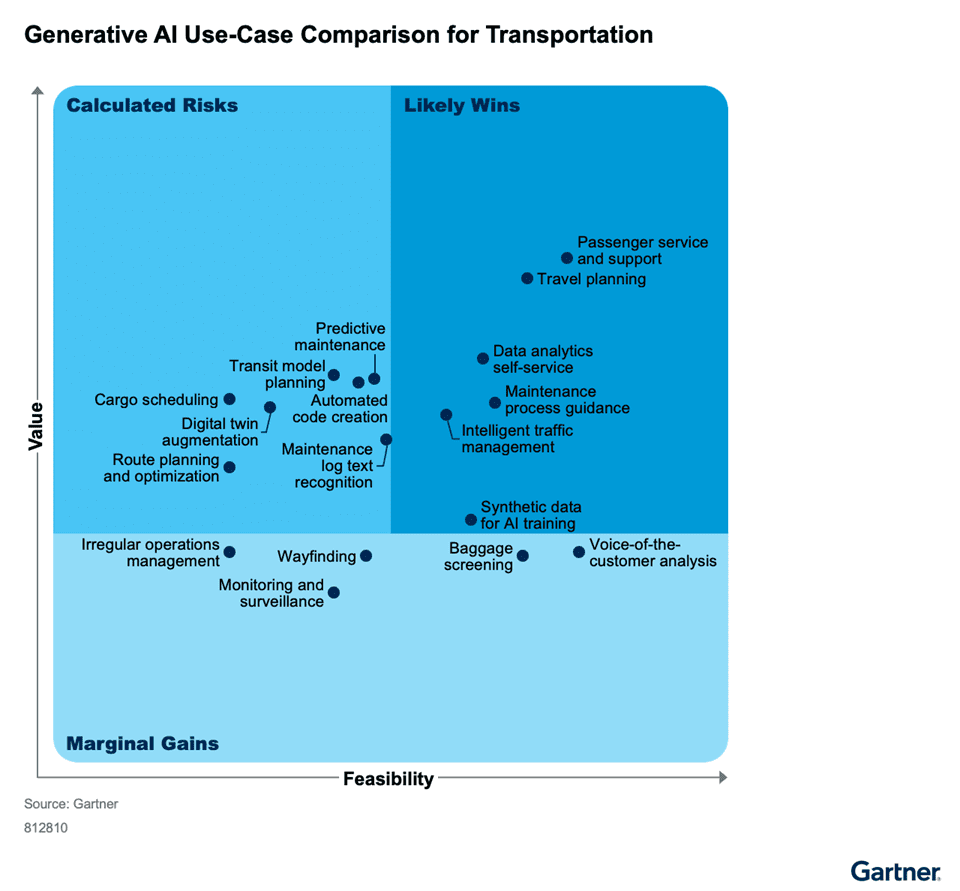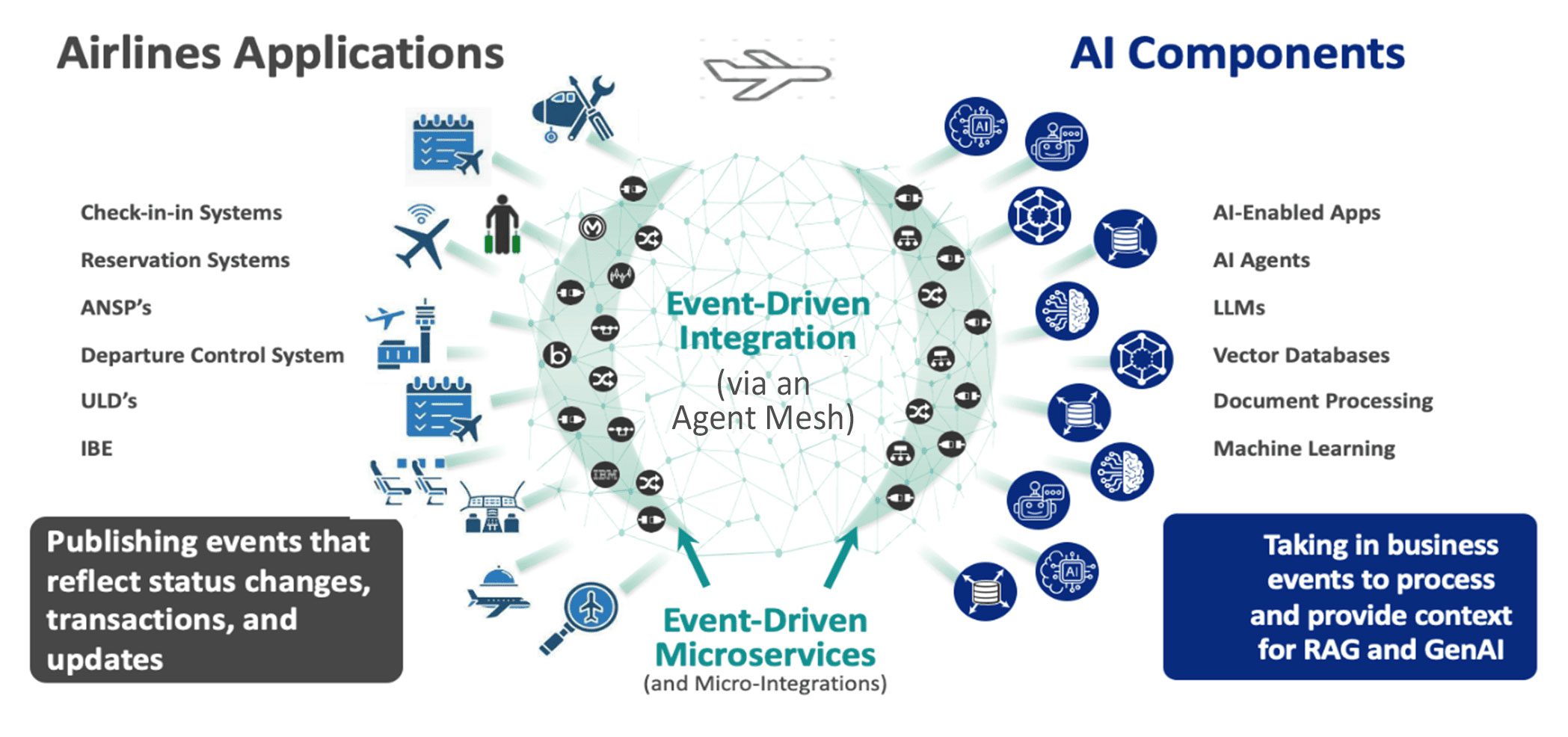Home > Blog > Artificial Intelligence
The introduction of artificial intelligence (AI) to the aviation industry is reshaping how aviation systems operate, and promises to revolutionize everything from passenger experience to operational efficiency and safety.
Subscribe to Our Blog
Get the latest trends, solutions, and insights into the event-driven future every week.
Thanks for subscribing.
As the industry embraces AI-driven solutions, we’re witnessing a transformation that extends beyond automation—it’s about creating intelligent, adaptive systems that can respond to the complex demands of modern aviation.
The global market for AI in aviation was valued at just over a billion dollars in 2024 and is projected to grow from $1.5B in 2025 to $32.5B by 2033, growing at a CAGR of 46.97% during the forecast period (2025-2033), according to Straits Research “Artificial Intelligence in Aviation Market”, Nov 12 2024.
Early AI Success Stories in the Aviation Sector
The aviation industry is already witnessing remarkable transformations through AI integration. Here are a few examples:
- Skywise, developed by Airbus, is an open data platform designed to enhance aviation operations by integrating and analyzing vast amounts of data from various sources, including aircraft sensors, maintenance logs, and flight operations. Leveraging artificial intelligence and machine learning, Skywise enables predictive maintenance, operational efficiency improvements, and data-driven decision-making. By processing real-time data and using AI capabilities, Skywise, facilitates the transformation of raw data into actionable insights, supporting the aviation industry’s move towards more intelligent and efficient operations.
- DATMS (digital airport traffic management system) is a new technology that uses AI to automate traffic control at airports, reducing the risk of human error. Such systems use radar and video cameras to track aircraft and vehicles on the ground, and can automatically activate or deactivate traffic lights based on the current situation, helping reduce tarmac incidents at airports.
- Air India recently became the first airline to implement a ChatGPT-like virtual agent, which they’ve named “Maharaja.” Maharaja helps customers with a wide range of inquiries, including flight status, baggage allowances, check-in procedures, and frequent flyer information. Since its pilot launch in March 2023, Maharaja has successfully managed over 500,000 customer queries, handling more than 6,000 interactions a day in multiple languages, significantly improving customer engagement and operational efficiency.
- Etihad Airways is going to enable flight bookings through a chat application. This will enable customers to book flights by simply entering their travel details into the app, with the AI completing the booking process, offering a convenient and innovative way to plan travel.
- Manchester Airport Group has started using AI to revolutionize passenger experience and airport operations through their Virtual Airport Liaison (VAL). At AWS re:Invent 2024, they shared how generative AI enhances customer experience with multilingual interactions and how computer vision optimizes aircraft turnarounds, saving millions and enabling real-time operational intelligence.
- At Stansted Airport, AI-powered kiosks address passenger queries and improve convenience, such as resolving signage issues when frequent questions about toilet locations arose. In arrivals, kiosks identified a trend of passengers seeking routes to London, creating a commercial opportunity to sell onward travel tickets and offer personalized services, like pre-booking return tickets and promoting airport amenities
How the Agent Mesh is Enabling the AI Revolution in Aviation
While AI brings powerful capabilities to aviation, the industry faces a fundamental challenge: How to effectively integrate these AI systems into the complex web of existing aviation infrastructure that spans ground operations, aircraft systems, reservation systems, departure control systems, passenger services, and maintenance operations. Traditional point-to-point integrations and hub-and-spoke architectures struggle to handle the real-time, distributed nature of modern aviation operations.
The solution is something called an agent mesh, which we enable with a solution called Solace Agent Mesh. The foundation of any agent mesh is an event mesh—a data distribution layer that enables the seamless flow of information across environments, organizations and locations. Agent mesh extends the idea of event mesh by introducing a network of autonomous AI agents that can reason about and act upon the information flowing through the mesh. Think of it as adding a layer of distributed intelligence to the aviation industry’s nervous system. While the event-driven backbone ensures that data and events flow precisely where they’re needed, autonomous agents monitor these streams, make decisions, and take actions—either independently or with humans in the loop as needed.
This combination of event-driven architecture (EDA) and autonomous AI agents effectively addresses aviation’s complex operational challenges.
As is the case with information technology in almost every industry, legacy aviation systems often operate in silos, with limited ability to share information or coordinate responses across domains. An agent mesh can break down these barriers by connecting systems and embedding intelligence throughout the network. The autonomous agents can understand context, learn from patterns, and orchestrate responses across multiple systems and stakeholders—all while maintaining the real-time performance and reliability that aviation operations demand.
For software architects, an agent mesh represents more than just another layer in the technology stack—it’s a paradigm shift in how we approach integration. By distributing data and intelligence across the enterprise, we can create systems that are connected and truly smart, capable of everything from predictive maintenance to real-time operational optimization and personalized customer service.
At its core, this architecture enables a new kind of aviation ecosystem—one where systems can autonomously coordinate, adapt, and respond to changing conditions. The event-driven foundation ensures real-time data distribution and agility in architecture evolution, while the network of AI agents provides the intelligent decision-making capabilities needed to tackle aviation’s most complex challenges. This combination creates a responsive, intelligent infrastructure that can transform how we approach everything from passenger experience to aircraft maintenance
Use Cases for Agent Mesh in Aviation
The true power of Solace Agent Mesh becomes apparent when we examine specific use cases that demonstrate its transformative potential.
Gartner recently published the following chart showing a variety of use cases that hinge on generative AI in the transportation industry.

Source: Gartner ”Generative AI Use-Case Comparison for Transportation” 20 Aug 2024, Shivani Palepu, Pedro Pacheco
Now I’d like to explore several compelling applications that showcase how an agent mesh can revolutionize aviation operations.
Customer Experience Orchestration
Picture a seamless passenger journey where an agent mesh enables real-time orchestration across all customer touchpoints. When a premium passenger enters the airport, the system immediately recognizes their presence through various sensors and begins orchestrating their experience. The mesh coordinates data from reservation systems, departure control systems (DCS), and check-in systems to create a personalized journey.
For instance, if a flight delay is detected, the system doesn’t just notify the passenger—it proactively coordinates alternatives. The system might automatically adjust the passenger’s lounge access duration, rebook connecting flights, and update ground transportation arrangements, all while keeping the passenger informed through their preferred communication channel using natural language thanks to an LLM.
Smart Baggage Handling
Baggage handling requires coordination across multiple systems and stakeholders. An agent mesh can streamline this process into an intelligent, self-optimizing system. The architecture enables real-time analysis of various factors includingflight schedules, baggage volumes, gate proximity, and belt occupancy rates.
When a flight arrives early, the agent mesh immediately triggers a cascade of coordinated actions. It automatically redirects baggage handling resources, adjusts belt assignments, and updates staff allocations. The system continuously monitors load distribution to prevent bottlenecks, using predictive analytics to anticipate and prevent potential issues before they occur. Each bag’s status is instantly shared across all relevant systems and stakeholders, creating a transparent and efficient operation.
Dynamic Resource Allocation
Agent mesh enables airports to achieve true situational awareness by integrating real-time data from multiple sources. Consider a scenario where an incoming flight reports a medical emergency. The agent mesh immediately coordinates multiple systems: it alerts medical services, adjusts gate assignments to minimize transit time for emergency services, updates ground handling schedules, and modifies connected flight gate assignments if necessary.
The system continuously processes events from various sources—flight schedules, passenger flow data, security checkpoints, and retail operations—to optimize resource allocation dynamically. When passenger flow increases unexpectedly at security checkpoints, the system can automatically request additional staff, open new lanes, and adjust downstream resources to accommodate the changing situation.
Fuel Efficiency Optimization
Airlines operate on thin profit margins, and with fuel consumption being a major cost driver—often accounting for around 30-35% of operating expenses—optimizing fuel efficiency is crucial for profitability. Airlines constantly seek innovative solutions to reduce fuel usage while maintaining operational efficiency.
An agent mesh enables the integration of real-time data from various sources, such as weather conditions, air traffic control updates, and aircraft sensor data. AI agents can analyze this data to adjust flight paths dynamically, reducing fuel burn by avoiding turbulent air or taking more direct routes based on real-time conditions.
Furthermore, an agent mesh can synchronize data from ground operations, load control systems and ATC allowing better load management and takeoff timings, ensuring that aircraft are not idling on the tarmac unnecessarily.
Streamlining Pre-Flight Approvals
Airlines operate in a highly regulated environment, where critical pre-flight checks like Weight and Balance, Maintenance Release Documentation, and Safety and Security Verifications must be completed to ensure operational safety. Currently, these approvals are often done manually, involving paperwork or digital sign-offs that require human validation, which can delay processes and introduce the potential for errors. Given the tight schedules and high stakes, there’s a growing need for a streamlined, secure method to complete these checks efficiently.
An agent mesh built with Solace’s platform and AI-driven edge agents can revolutionize these pre-flight processes through Voice-based e-Cert sign-offs. This enables ground and maintenance crews to complete approvals using voice recognition, with AI securely authenticating each individual’s voice. Once verified, these sign-offs are instantly logged into interconnected systems, removing manual bottlenecks and reducing paperwork. Additionally, the agent mesh enables real-time situational awareness across the ecosystem by linking data from maintenance records, operational systems, and load control. AI agents continuously monitor this data, alerting teams to any incomplete tasks or safety concerns, thereby accelerating decision-making, minimizing delays, and enhancing overall efficiency in the airline’s operations.
Revenue Optimization
In the commercial aviation space, an agent mesh can help companies optimize revenue through real-time market analysis and dynamic pricing using large market models (LMM). With an agent mesh in place airlines’ systems can process vast amounts of data—competitor pricing, historical booking patterns, real-time demand indicators, and external events—to continuously optimize ticket pricing.
The event-driven nature of the information flow ensures that pricing decisions are instantly pushed across all sales channels to maintain consistency across inventory systems and revenue management rules. When market conditions change, such as a competitor’s pricing adjustment or a sudden surge in demand, the system can instantly respond while considering the broader implications for network-wide revenue optimization.
Technical Implementation Considerations
Software architects must carefully consider several key aspects when implementing agent mesh solutions in aviation.
- Performance:The system must handle high-throughput event streams from various sources while ensuring guaranteed message delivery without the risk of data loss, even in rate mismatch situations where some systems can’t keep up with the streams of data higher speed systems generate.
- Inclusiveness: System integration presents another critical challenge. The architecture must support multiple protocols while providing data transformation and normalization capabilities.
- Adaptabilty:The system must make it easy to add and upgrade components such as agents and language models.
- Security and Compliance: Security and compliance requirements add another layer of complexity. The architecture must implement end-to-end encryption, robust access controls, and comprehensive audit logging while maintaining compliance with aviation industry regulations. These security measures must be implemented without compromising system performance or reliability.
Building Aviation’s Future with AI
The implementation of an agent mesh in aviation requires a thoughtful, phased approach. The first step is to establish a solid event mesh foundation with distributed event brokers and smart routing capabilities. This foundation supports the subsequent integration of AI services and various data sources, creating a nimble integration platform for aviation operations.
The integration of existing aviation systems requires careful consideration of legacy systems and data synchronization requirements. By implementing appropriate micro-integrations and data transformation services, architects can ensure seamless integration while maintaining system reliability and performance.
The aviation industry’s future depends on the ability to architect systems that can handle the complexity of modern operations while enabling innovation. An agent mesh, powered by event-driven patterns and AI capabilities, provides the foundation for this transformation. As technology leaders in this domain, we have the opportunity—and responsibility—to help companies design systems that redefine the future of aviation operations. By embracing Solace Agent Mesh, we can create more intelligent, responsive, and efficient aviation systems that will serve the industry for years to come.
Explore other posts from category: Artificial Intelligence

Alam is a principal architect at Solace, bringing to the company extensive expertise in middleware technologies, APIs, integration strategies, and event-driven architecture. He has worked with leading companies such as Emirates Airlines, Indigo Airlines, Citibank, Bank of Montreal, Telia Sonera, and Wyndham Group, playing a key role in their digital transformation journeys.
Alam has successfully delivered innovative solutions across diverse industries, including retail, aviation, and banking, enabling clients to achieve agility, scalability, and operational excellence. His ability to align technology with business goals has made him a trusted advisor in crafting innovative strategies for global enterprises.

Ali Pourshahid is Solace's chief engineering officer, leading the engineering teams at Solace. Ali is responsible for the delivery and operation of software and cloud services at Solace, and works closely with product management on product strategy. He leads a team of incredibly talented engineers, architects, and user experience designers in this endeavor. Since joining, he's been a significant force behind Solace Cloud, Solace Event Portal, and Solace Insights products. He also played an essential role in evolving Solace's engineering methods, processes, and technology direction. Most recently, Ali has played a pivotal role in shaping and driving the company’s AI strategy, products, and adoption.
Before Solace, Ali worked at IBM and Klipfolio, building engineering teams and bringing several enterprise and cloud-native SaaS products to the market. He enjoys system design, building teams, refining processes, and focusing on great developer and product experiences. He has extensive experience in building agile product-led teams.
Ali earned his Ph.D. in Computer Science from the University of Ottawa, where he researched and developed ways to improve processes automatically. He has several cited publications and patents and was recognized as a Master Inventor at IBM.


Subscribe to Our Blog
Get the latest trends, solutions, and insights into the event-driven future every week.
Thanks for subscribing.


